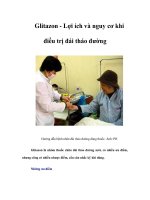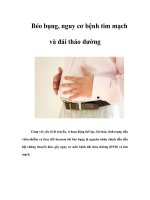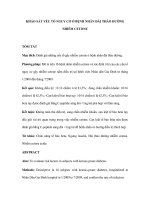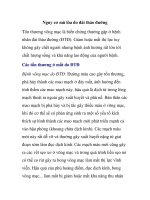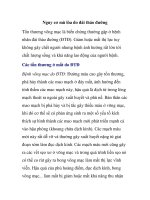Giảm nguy cơ tim mạch trong đái tháo đường típ 2 bằng can thiệp vào đường huyết sau ăn
Bạn đang xem bản rút gọn của tài liệu. Xem và tải ngay bản đầy đủ của tài liệu tại đây (1.17 MB, 31 trang )
PGS.TS.BS NguyễnThị Bích Đào
Bộ môn Nội tiết- ĐH YD Tp HCM
Giảm nguy cơ tim mạch trong Đái tháo đường típ 2
bằng can thiệp vào đường huyt sau ăn:
khi nào và như th nào?
Các câu hỏi chủ yếu
Q1: ĐH sau ăn có ảnh hưởng đến CVD như thế nào?
Q2: Điều trị ĐH sau ăn có lợi ích trong cải thiện các kết cục
lâm sàng trên CVD không?
Q3: Can thiệp khi nào và như thế nào?
Oxidative
Stress
Cellular
Dysfunction
AGE Formation
Cell
Damage
Hexosamine
Pathway
ROS
ROS
Glucose
Peripheral & Autonomic Neuropathy
Nephropathy
Retinopathy
Vascular
Damage
Different complications (eye, kidney, nerve, blood vessels) arise from limited number of
triggers perturbing a limited number of metabolic pathway(s)
(Brownlee, 2001)
Mối liên quan giữa đường huyt và CVD
BG, blood glucose; AUC, area under the curve; CGM continuous glucose monitoring curve; SMBG, self-monitored blood glucose.
Borg R, et al. Diabetologia 2011;54:69-72.
Upper bar, type 1 diabetes, lower bar, type 2 diabetes, middle bar, both.
Ảnh hưởng của tăng đường huyết sau ăn
Yếu tố nguy cơ độc lập của bệnh lý mạch máu lớn
Tăng sớm và tăng nhanh hơn ĐH khi đói
Góp phần nhiều hơn mức đường huyết đói vào sự hình thành
HbA1c khi HbA1c < 8.5%
Yếu tố làm giới hạn kiểm soát ĐH tốt.
5
Blood coagulation
Fibrinolysis
Platelet adhesion
Oxidative stress
IMT
Endothelial dysfunction
( NO release)
Insulin resistance
CVD and MI
Postprandial
hyperglycaemia
Ảnh hưởng của đường huyết sau ăn
trên tim mạch và các marker
CVD: cardiovascular disease; IMT: intima-media thickness; MI: myocardial infarction; NO: nitric oxide.
DECODE
2001
2
Pacific and
Indian Ocean
1999
3
Funagata
Diabetes Study
1999
4
Whitehall, Paris and
Helsinki Study 1998
5
Diabetes
Intervention Study
1996
7
Rancho Bernardo
Study 1998
6
Postprandial
hyperglycaemia
Honolulu
Heart Program
1987
8
Cardiovascular
mortality
CHD: coronary heart disease; CVD: cardiovascular disease; DECODA: Diabetes Epidemiology, Collaborative Analysis of Diagnostic Criteria in
Asia; DECODE: Diabetes Epidemiology, Collaborative Analysis of Diagnostic Criteria in Europe
1. Nakagami T, et al. Diabetologia 2004;47:385–94. 2. DECODE. Arch Intern Med 2001;161:397–405.
3. Shaw J, et al. Diabetologia 1999;42:1050–54. 4. Tominaga M, et al. Diabetes Care 1999;22;920–24.
5. Balkau B, et al. Diabetes Care 1998;21:360–67. 6. Barrett-Connor E, et al. Diabetes Care 1998;21:1236–39.
7. Hanefeld M, et al. Diabetologia 1996;39:1577–83.
8. Donahue R. Diabetes 1987;36:689–92.
DECODA
2004
1
Liên hệ giữa đỉnh ĐH sau ăn
và tử vong do CHD
PPG & 2hPG kết hợp với nguy cơ biến cố CVD và
tử vong do mọi nguyên nhân cao hơn so với FPG.
<6.1 6.1–6.9 7.0
11.1
7.8–11.0
<7.8
Fasting plasma glucose (mmol/l)
2.5
2.0
1.5
1.0
0.5
0.0
Hazard ratio
Adjusted for age, center, sex
DECODE Study Group. Lancet 1999;354:617–621
Relative risk for death increases with 2-hour blood glucose
irrespective of the FPG level
9
Đường máu sau ăn dự báo biến cố tim mạch
trong thời gian 5 năm (chỉ ĐH sau ăn trưa)
During the 5-year follow-up, 77 subjects (14.6%) experienced CVD events (19% m, 9.4% f)
Tỷ lệ nguy cơ
CI: 1.45 - 21.20
(n=23)
CI: 1,04 – 4,32
(n=54)
2,12
5,54
0
1
2
3
4
5
6
Nam Nữ
Cavalot, et al J Clin Endocrinol Metab 2006;91:813-819
(hazard ratio of 3
rd
tertile vs 1
st
and 2
nd
tertiles greater in women than in men (5.54, CI 1.45-21.20 and
2.12, CI 1.04-4.32, respectively, P <0.01).
“The observations also extend to people with diabetes with PPG being a
stronger predictor of CV events than FPG in T2DM, particularly in women
48
,
data which have been confirmed in a longer follow-up
61
.”
Down loaded from IDF home page: www.idf.org. / [48] J Clin Endocrinol Metab 2006;91:813-819 / [61] Diabetes Care 2011;34:2237–2243
Blood glucose control parameters were categorized according to achievement of ADA 2010
therapeutic targets. In model 1, the five blood glucose parameters were considered independently.
CIMT = carotid-intima-media thickness.
Tăng đường huyết sau ăn có gây hại không?
Tăng đường huyết sau ăn là yếu tố nguy cơ độc lập đối với bệnh
lý mạch máu lớn.
[Level 1+]
Tăng đường huyết sau liên quan tới
• Gia tăng nguy cơ bệnh lý võng mạc, tăng CIMT, giảm thể tích
máu / dòng máu đến cơ tim, tăng nguy cơ ung thư, suy giảm
chức năng nhận thức ở người già.
• Phát triển oxidative stress, viêm, và rối loạn chức năng nội
mạc mạch máu.
[Level 2+]
Kết luận
Mức độ
bằng chứng
Điều trị nào ảnh hưởng đn kiểm soát đường huyt
sau ăn?
Basal glucose
level
HbA
1c
Đường huyt sau ăn
HbA
1c
= glycated haemoglobin;
FPG = fasting plasma glucose.
ĐH đói
Average long-term
glucose level
“Bộ ba đường huyt”
Trong quản lý Đái tháo đường
Điều trị nào ảnh hưởng đn kiểm soát đường huyt sau
ăn?
Chế độ ăn với chỉ số tải đường thấp thì hiệu quả trong
cải thiện kiểm soát đường huyết.
[Level 1+]
Một số loại dược phẩm có tác dụng làm giảm glucose
sau ăn.
[Level 1++]
IDF
Mức độ
bằng chứng
Down loaded from IDF home page: www.idf.org.
Các thuốc ảnh hưởng đến đường huyết sau ăn:
• α-glucosidase inhibitors
• glinides (rapid-acting insulin secretagogues)
• short-acting SU
• insulins: rapid-acting human insulins/insulin analogues - biphasic [premixed]
human insulins/ insulin analogues
Các thuốc thế hệ mới ảnh hưởng đến ĐH sau ăn:
• GLP-1 derivatives
• DPP-4 inhibitors
Glucobay acts non-systemically to delay
carbohydrate absorption
1
Upper small
intestine
Lower small
intestine
Without
Glucobay
Carbohydrate
absorption
Carbohydrates
Stomach
With
Glucobay
Carbohydrate
absorption
1. Glucobay Summary of Product Characteristics.
Bischoff H. Clin Invest Med 1995;18:303–11.
PPI
Breakfast
Lunch Dinner
Blood glucose (mg/dL)
Without
Glucobay
With
Glucobay
8 9 10 11 12 13 14 15 17 18 19 20
150
140
120
100
80
Time of day (h)
Glucobay reduces postprandial blood glucose surges
Van de Laar F, et al. Diabetes Care 2005;28:166–75.
30 randomised,
placebo-controlled trials
0
–0.5
–1.0
–1.5
0
–1.0
–2.0
–3.0
–4.0
−2.3
−0.8
Change in plasma glucose
(mmol/L)
Change in HbA
1c
(%)
(CI 95%: −0.90,−0.64)
(n=2,831)
(CI 95%: −2.73, −1.92)
(n = 2,238)
−1.1
(CI 95%: −1.36, −0.83)
(n = 2,838)
Fasting Postprandial
Glucobay monotherapy provided glycaemic control in
patients with type 2 diabetes compared with placebo
HbA
1c

